American Journal of Plant Sciences
Vol.5 No.4(2014), Article ID:43255,10 pages DOI:10.4236/ajps.2014.54060
Root Growth, Nutrition and Yield of Maize with Applied Different Limestone Particle Size in the Cerrado Soil
![]()
1Departamento de Engenharias, Agronomia, Campus Professora Cinobelina Elvas, Universidade Federal do Piauí, Bom Jesus, Brazil; 2Instituto de Ciências Agrárias, Universidade Federal de Uberlândia, Uberlândia, Brazil; 3Embrapa, Centro Nacional de Pesquisa no Cerrado, Planaltina, Brazil; 4Programa de Pós-Graduação em Agronomia, Universidade Federal de Goiás, Goiânia, Brazil.
Email: rfratke@gmail.com
Copyright © 2014 Rafael Felippe Ratke et al. This is an open access article distributed under the Creative Commons Attribution License, which permits unrestricted use, distribution, and reproduction in any medium, provided the original work is properly cited. In accordance of the Creative Commons Attribution License all Copyrights © 2014 are reserved for SCIRP and the owner of the intellectual property Rafael Felippe Ratke et al. All Copyright © 2014 are guarded by law and by SCIRP as a guardian.
Received December 6th, 2013; revised January 6th, 2014; accepted January 18th, 2014
KEYWORDS
Limestone; No-Tillage; Zea Mays
ABSTRACT
The limestone with smaller particle size provides rapid correction of soil acidity. However, the limestone with large particles can promote bigger root growth, and may still have a residual effect on the soil. The aim of this study was to evaluate the residual effect of the application and incorporation of different limestone with a particle size bigger than 0.30 mm in root growth, nutrition and yield of maize in Cerrado soil. A randomized completed block utilized in this experiment, with five treatments and four replications. The grain sizes of dolomitic limestone incorporated into the Oxisol were: 0 (control, no-lime), 2.00 - 0.82 mm, 0.82 - 0.56 mm, 0.56 - 0.30 mm, 0.30 - 0.20 mm, in doses of 6.5 t∙ha−1, 3.9 t∙ha−1, 2.6 t∙ha−1 and 1.3 t∙ha−1 respectively. The limestone applied in introduction no-tillage. The maize were evaluated of root attributes, nutrition and grain yield in two years 2009 and 2010. The use of limestone particle size of 2.00 - 0.82 mm, and the quantity of 6.5 t∙ha−1 applied to the soil and incorporated showed elongation and root growth of maize thin depth of 20 - 40 cm in the soil. In that, same proposed management of the limestone was the highest maize grain yield in the first year. The rooting characteristics evaluated correlated with leaf Ca and Cu and maizegrain yield.
1. Introduction
Systematic studies of the root system began in the eighteenth century, with the simple technique of excavation, observing the root system of cultivated plants and determining their morphology, weight and growth. With the increase of mineral fertilizers in agriculture in the second half of the nineteenth century, scientists interested in the study of agronomic roots have developed other techniques to study the dynamics of roots in the soil [1]. However, with less technological advances, root development and its influence on nutrition and crop production are little studied.
The roots constitute about 33% of the overall net primary productivity, and the inlet of carbon and nutrients in the soil from the roots is equal to or bigger than that
provided by the leaves [2]. Despite its importance in understanding the terrestrial ecology, nutrient cycling and carbon, little information exists about its basic characteristics (biomass, length and surface area). This lack of studies is due mainly to the difficulties related to its determinations. Furthermore, root growth responds to soil management. Changes in the characteristics of the soil due to use of systems like no-tillage (NT) and liming changes the root growth.
The NT was installed in a systematic manner in all agricultural regions of Brazil, especially in the Cerrado. However, there are still investigations to elucidate the problem of lack of response to fertilizer and liming areas NT long term that may be linked to low efficiency of liming. According [3], in a liming experiment in NT consolidated application of gypsum with or without liming on the surface or incorporated, there was an interesting strategy for the establishment of no-tillage soybeans, since no improvement in production grain and even the very soil amendment .
The choice of species or crops used in NT depends on the adaptation of the climatic conditions of each region and the interest of the producer. In this perspective, the cultures of bigger economic interest in the Brazilian Cerrado are soybeans and maize. The maize crop rotation with soybeans in NT in central Brazil, contributes to the permanence of their trash in the winter, due to its low C: N ratio, favoring the soil cover, organic matter mineralization, and control weeds [4].
The great than the maize root lies in the depth 0 - 20 cm due to applied lime in surface soil in NT. Thus, this depth also showed too, a higher pH, higher organic carbon concentration and lower concentration of Al toxicity. Furthermore, the density of roots of maize (cm root per cm3 of soil) was significantly correlated positively with the concentration of nutrients in surface soil [5]. The application of lime in the soil in conventional tillage causes considerable increase in maize production. The suitability of soil fertility and the correction of its acidity favor root development of maize plant [6].
The application of higher doses and bigger particle prolonged residual effect on the chemical on Oxisol [7]. The time reactivity of lime in the soil may waive the use of more liming, favoring the accumulation of organic matter by the use of no-tillage system. Thus, keeping the buffer capacity of the soil, or maintaining the pH that favors the availability of nutrients in the soil solution by providing the growth of roots.
The application of limestone with a particle size bigger than 0.30 mm (Table 1) in excess of the recommended dose and incorporated into the soil in tillage adoption favors the time correction of soil acidity and supply of Ca and Mg. The objective of this work was to verify the influence of the use of limestone with particle sizes bigger than 0.30 mm embedded in the soil attributes in root,
the leaf contents of macro and micronutrients and productivity of maize in introduction of NT in Oxisol of Cerrado.
2. Materials and Methods
The experiment was installed in October 2009 in an experimental field near Goiânia-Goiás, located at latitude: 16˚36'6.91''S, Longitude: 49˚16'57.22''WO. The soil of this research was characterized with dystrophic Red Oxisol. The climate as classified as tropical rainy Aw savannah, having a sub-humid climate, with two distinct seasons: a drought lasting four to five months, and a rainy season occurring from late September to April, according Köppen Climate.
The experimental design was a randomized complete block with five treatments and four replications. The treatments consisted of four particle size classes limestone and a control treatment (no lime application). The limestone used in the experiment was classified as dolomite extracted from metamorphic rocks, with 38% de CaO and 13% MgO (Table 1). The limestone was divided into the desired particle classes through appropriate sieves.
The need for liming (NL) was calculated by the base saturation:

where V2 is base saturation required by the crop, if we used 50%, V1 is base saturation current soil, T is the cations exchange capacity of the soil current total. The calculation of liming was based on the results of soil analysis before the experiment, the depth 0 - 20 cm depth (Table 2). The dose was calculated at 1.30 Mg∙ha−1 whereas the depth of embedding of 0 - 20 cm and neutralization power equal 100%. The treatments had their rates adjusted as function of reactivity (Table 1).
The area of the experiment was no fallow crop planted for two years prior to the implementation of this experiment. Before that, it was used as a demonstration area for crops such as soybeans, maize and wheat. In both years
3. Results and Discussion
The use of limestone in different particle size distribution did not change the root of the maize plant at 0 - 20 cm soil in 2009. In that year, the maize had bigger CREM using limestone to a particle size of 2.00 mm to 0.82 mm (Table 3). The residual effect of limestone in larger than 0.30 mm was also observed by [7,12,13].
The effectiveness of corrective materials soil acidity is measured only by the relative power of total neutralization (PRNT) according to the current legislation for limestone in the Brazil [14]. However, the residual effect of lime and root growth promoted by it not should be considered to measure its efficiency in Brazil. Thus, this information should be used to evaluate soil acidity corrective. Furthermore, the effectiveness of these correctives should consider the residual power of these limestones and crop response and not only the PRNT [15]. Else, in this work, the use of limestone in different particle sizes was effective on root development of maize plants.
Root attribute maize influenced by liming with differ-
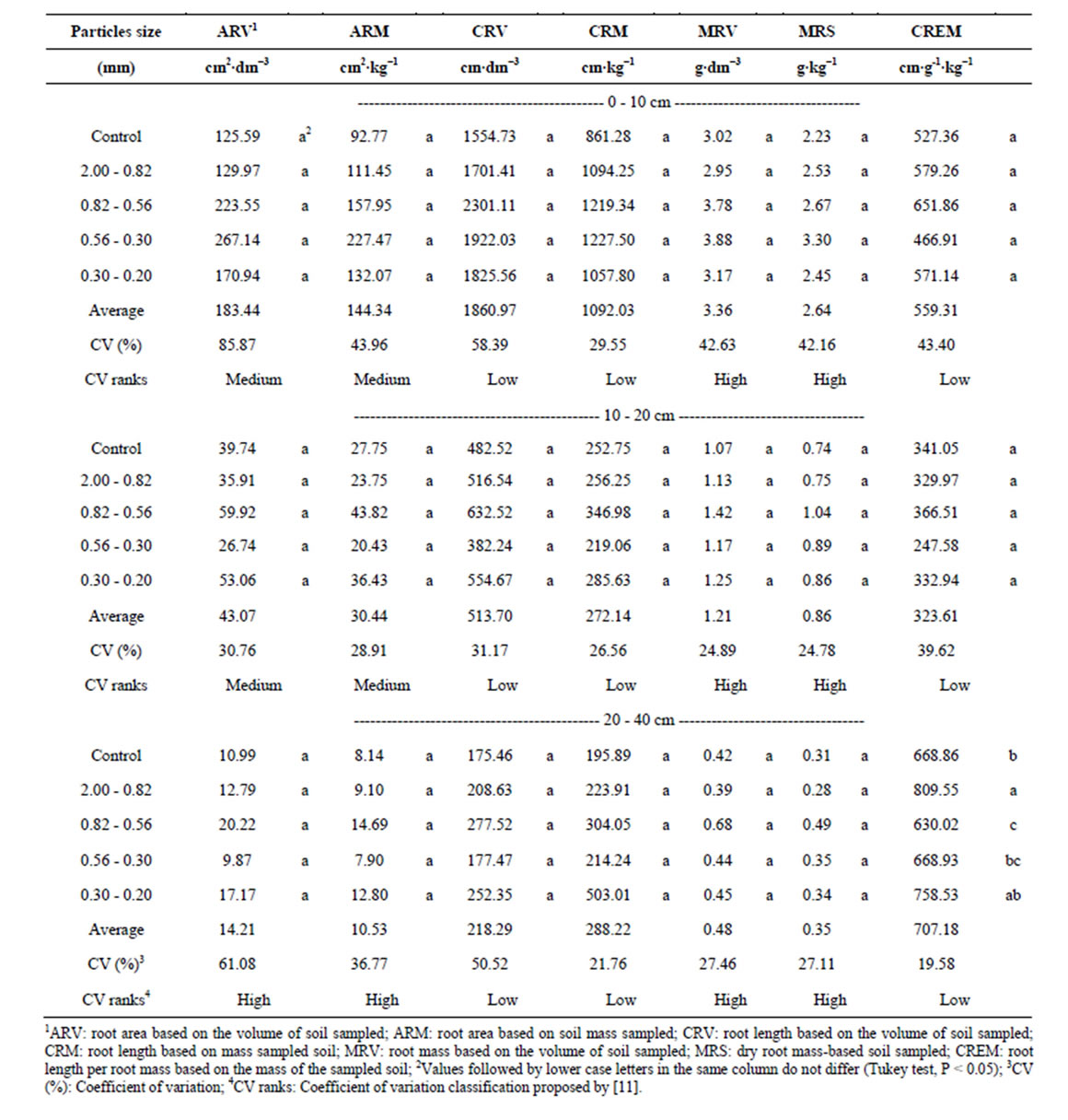
Table 3. Average values of attributes root of maize with application the lime in different particle size, in three soil depths (0 - 10 cm, 10 - 20 cm and 20 - 30 cm). Year 2009.
ent particle sizes, in all soil depth, presented probability distribution that deviated from normal in the two years of study. Thus, the classification of CV proposed by [11] was utilized to verify the efficiency of this variability data.
The CV values were average for ARV and ARM maize in the 0 - 10 cm and 10 - 20 cm depth, and high in the 20 - 40 cm soil depth. The average results from CRM, CREM CRV and had low CV values in all soil depths. The average results of MRV and MRS at high CV values in all soil depths, in 2009. Given these data, it can be said that the method was efficient auger to describe the characteristics of maize root development with the use of lime in the soil for the parameters involving root length. Have to root mass, the auger method showed high CV values which may not reflect the reality of the root growth of maize through the use of limestone, due to the large variability in the data. However, it was essential that all parameters of roots were observed to generate the CREM attribute, which found that the use of limestone incorporated into the soil with a particle size bigger than 0.30 mm favored root development of maize in the 20 - 40 cm depth soil.
The limestone with a particle size between 0.56 mm to 0.30 mm provided bigger root mass of maize per soil volume (MRV), and particle size 0.30 mm to 0.20 mm caused bigger root mass per mass of maize soil (MRS) in the 0 - 10 cm soil depth in 2010 (Table 4). Already on

Table 4. Average values of attributes root of maize with application the lime in different particle size. in three soil depths (0 - 10 cm, 10 - 20 cm and 20 - 30 cm). Year 2010.
depth 10 - 20 cm depth, the use of limestone with a particle size between 2.00 mm and 0.82 mm promoted larger area (MRA) and root length (CRM) maize. This same effect was found with particle size 0.30 to 0.20 mm for ARM in this work.
In 2010, the CV values were high for ARV and ARM maize in all soil depths. The average results of CRM and CRV and CREM had mean CV in the 0 - 10 cm depth and low in the 10 - 20 cm and 20 - 40 cm soil depth. The average results of MRV and MRS at high CV values in all soil depths. The CREM had average CV values in the 0 - 10 cm depth, and high in the 10 - 20 cm and 20 - 40 cm soil depth. However, the root length of maize was effectively described by the auger method.
The development of roots in the soil is prone to large variability because soils are very heterogeneous, even in experimental field condition, where it seeks to standardize the treatments increasing the number of samples per plot, this is hardly achieved. However, following the proposal of [11], the CV values are proportional data obtained when the data do not show normality. Therefore, the maize root parameters were influenced by the use of different particle sizes even with large limestone data variability.
The effective depth of the root system of maize is between 0.40 m to 0.46 m regardless of the system used, no-tillage or tillage [16]. Therefore, the limestone with different particle sizes provided that the roots of maize reached their effective depth in the soil. Since the particle size of 2.00 mm to 0.82 mm, promoted bigger volume of fine roots of maize that depth. Thus, resulted in a bigger use of land and nutrient absorption by the plant.
[17] also observed that the incorporation of lime and gypsum did not favor the growth of maize root system under NT. Already, [18] reported that maize root growth is affected by the concentration of Al in the soil. Like this, the limestone with large particle sizes in the soil promoted the precipitation of Al in the depth 20 at 40 cm, and this favored root growth of maize plants in the first and second year.
The thinner maize had roots in the amount of CREM depth 20 to 40 cm from the ground with the use of limestone of different particle size. Pursuant to, limes were effective to promote rooting of plants. Furthermore, [19] reported that the incorporation of lime dose of 6.8 t∙ha−1 in a sandy loam, promoted root growth of maize to 0.45 m depth in the soil, compared to liming.
The values of root length density (CRV) and (CRM) in the first year were higher than those found by [16]. These authors reported that the roots of maize in two cropping system, direct and conventional, were with root length density around 1.0 cm−3 cm to 1.5 cm∙cm−3 while using different particle sizes limestone this value was about 0.02 cm∙cm−3 to 2.30 cm∙cm−3 depending on the soil depth. In this sense, it shows that the root development of maize is related to the use of lime and soil depth in which this limestone corrects soil acidity.
The application and incorporation of particle size of 0.56 mm to 0.30 mm limestone soils decreased the concentration of Ca and Fe in maize leaves in the second year (Tables 5 and 6). Thus, the particle sizes of limestone thicker and higher dose provided equivalent levels of Ca, Mg, Cu, Fe, Mn and Zn in the leaves of maize compared to finer particle sizes , with the exception of particle size of 0.56 mm to 0.30 mm. In this sense, the application of lime to lower reactivity and higher volume did not impair the nutrition of the maize plant during the two years of cultivation.
The expected result in foliar nutrition of maize with the use of limestone in different particle sizes was that foliar Ca and Mg is increased as found by [6]. This author describes the application of lime increased the Ca
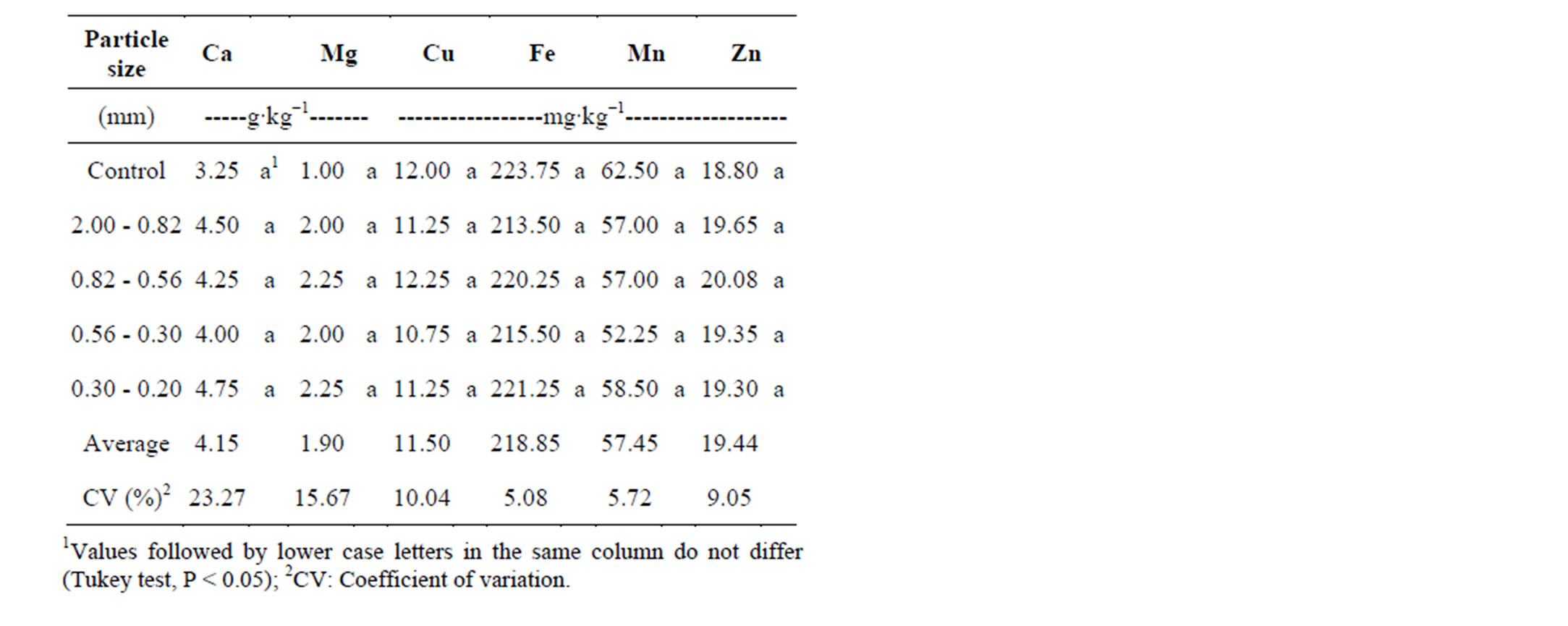
Table 5. Average values of nutrients in leaves of maize with application different particle size of limestone. Year 2009.
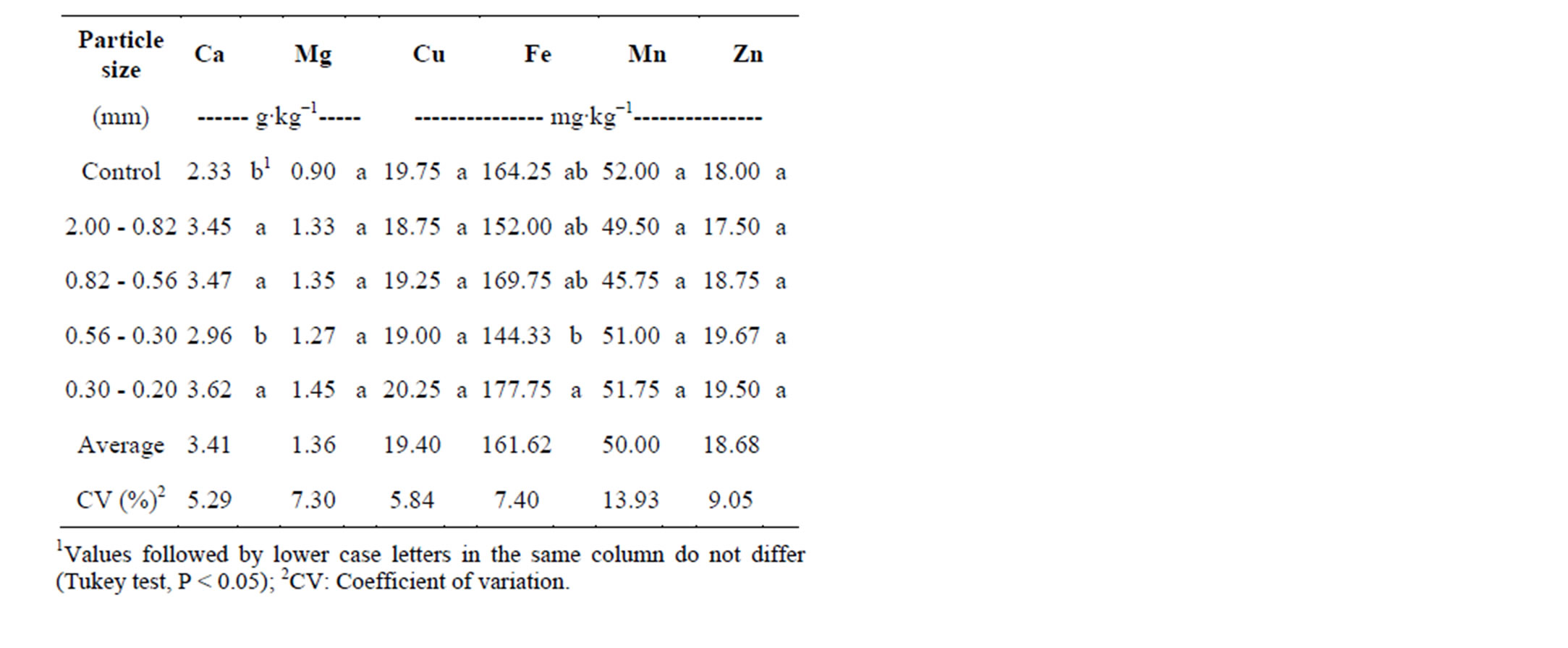
Table 6. Average values of nutrients in leaves of maize with application different particle size of limestone. Year 2010.
and Mg and reduced the concentration of K in the leaves of maize, while the Re-liming did not significantly alter the nutrient content. In fact, this has not occurred in this study due to the supply of Ca and Mg in soil with the use of limestone with particle size bigger than 0.2 mm and suitable to be slow, causing no chemical imbalance in the supply of nutrients for the plants maize which resulted in their nutrition.
According to [20], the application and incorporation of lime promotes significant reduction in the concentrations of Zn, Fe and Mn in leaves of maize in three of the four years studied, and Cu concentrations were not affected by the addition of lime. However, [17] found no influence of lime incorporation levels of macronutrients in maize leaves. Therefore, the present study agree with the work of [20] due to the fact that the limestone with a particle size of 0.56 mm to 0.30 mm decreased the concentration of Fe in leaves of maize in the second year. Trought, [17] showing that reactivity of lime with that grain size decreased the concentration of Ca.
The Ca and Mn in leaves of maize not showed significant correlation in 2009. Thus, attributes ARV, ARM, CRV, CRM and CREM maize significantly correlated with foliar Cu. Furthermore, ARV values correlated significantly with the ARM, CRV, CRM and CREM. Besides, the Ca in maize values correlated significantly with the Mn in leaves of maize (Table 7). Therefore, root development interfered with foliar nutrients and this reflected in the productivity of maize.
In 2010 there was also a significant correlation between MRV and yield of maize and values ARM ARV, CRV, CRM and CREM, and MRV with MRS significantly correlated with each other (Table 8). Even with these correlations, the root development of maize provided by the use of limestone with different particle size did not result in increased levels of nutrients in maize leaf and grain yield of maize.
Most maize grain yield was found with the use of limestone particle size 2.00 mm to 0.82 mm in the first year (Table 9). That same particle size was found to further development of fine roots (CREM) in the depth 20 - 40 cm soil depth. Even so, there was no correlation between this particle and maize production.
The distribution and activity of roots determine the amount of water and nutrients absorbed [21]. Thus, the use of limestone with large particle sizes (2.00 mm to 0.82 mm) improved root distribution in the soil and this allowed the correlation between the absorption of nutrients like Ca and Mg in the case and also in the production of grain maize in the second year. But this influence root development did not reflect a significant difference between the use of limestone in different particle sizes for the production of maize in the second year.
The method of the monolith adapted from [1] to study
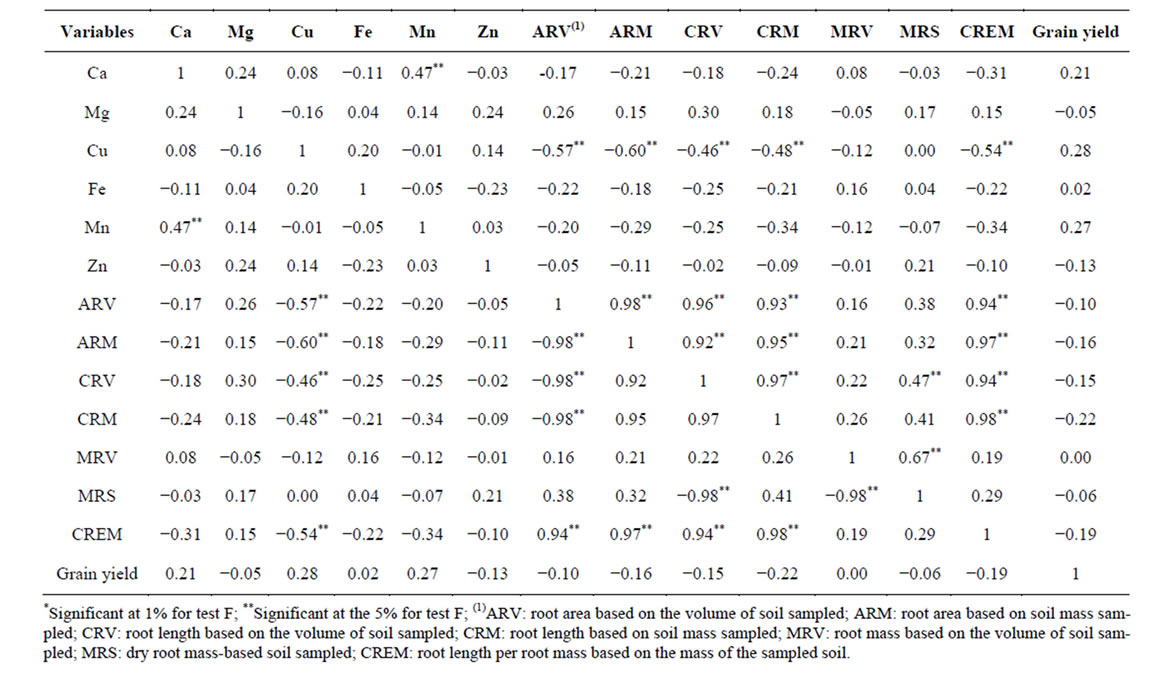
Table 7. Pearson correlation between Ca, Mg, Cu, Fe, Mn and Zn in leaves of maize, root attributes and grain yield of maize with application different particle sizes of limestone. Year 2009.

Table 8. Pearson correlation between Ca, Mg, Cu, Fe, Mn and Zn in leaves of maize, root attributes and grain yield of maize with application different particle sizes of lime. Year 2010.
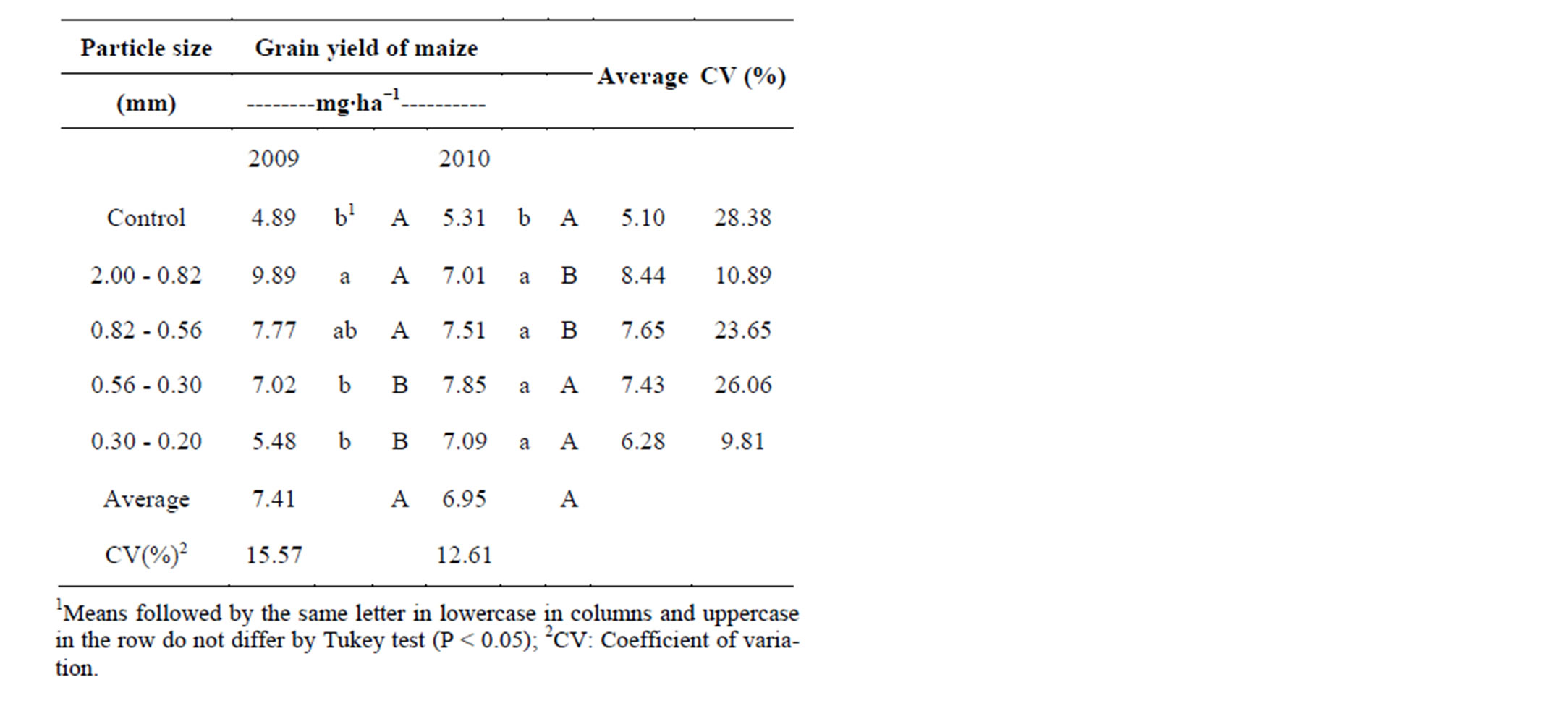
Table 9. Grain yield of maize (mg∙ha−1) with application different particle size of lime, in two year (2009 and 2010).
the maize root development with the use of lime and applied superficially embedded in dystrophic Argisol [18]. This method requires the opening of a trench to observe root development. Thus, the auger method is more practical because of no need of opening a trench in the study of maize roots and shows the possibility of study parameters between root area, length and weight of maize roots.
4. Conclusion
The further development of fine roots of maize (CREM) is found with the use of lime particle size of 2.00 mm to 0.82 mm in the first year. The root development of maize influences the absorption of Ca, Mn and Cu, as well as in the production of maize. The methodology auger associated with the processing of images of roots is efficient to check the response of maize to soil acidity corrective.
REFERENCES
- W. Bohm, “Methods of Studing Root Systems,” In: W. D. B. Durham, F. G. Athens, O. L. L. Wurzburg and J. S. O. Oak Ridge, Eds., Ecological Studies: Analysis and Syntesis, Springer, New York, 1979, pp. 92-138.
- J. J. Hendrick and K. S. Pregitzer, “Patterns of Fine Roots Mortality in Two Sugar Maple Forest,” Nature, Vol. 361, No. 6407, 1993, pp. 59-61. http://dx.doi.org/10.1038/361059a0
- E. F. Caires, J. Blum, G. Barth, F. J. Garbuio and M. T. Kusman, “Alterações Químicas do Solo e Resposta da Soja ao Calcário e Gesso Aplicados na Implantação do Sistema Plantio Direto,” Revista Brasileira de Ciência do Solo, Vol. 27, No. 2, 2003, pp. 275-286. http://dx.doi.org/10.1590/S0100-06832003000200008
- C. A. Cerettaand M. R. Fries,“Adubação Nitrogenada no Sistema Plantio Direto,” In: N. J. Neumberg, Ed., Conceitos e Fundamentos do Sistema Plantio Direto, Sociedade Brasileira de Ciência do Solo, Lages, 1998. pp. 111- 120.
- V. R. Silva, D. J. Reinert and J. M. Reichert, “Densidade do Solo, Atributos Químicos e Sistema Radicular do Milho Afetados pelo Pastejo e Manejo do Solo,” Revista Brasileira de Ciência do Solo, Vol. 24, No. 1, 2000, pp. 191-199.
- E. F. Caires, G. Barth, F. J. Garbuio, F. J. and M. T. Kusman, “Correção da Acidez do Solo, Crescimento Radicular e Nutrição do Milho de Acordo com a Calagem na Superfície em Sistema Plantio Direto,” Revista Brasileira de Ciência do solo, Vol. 26, No. 6, 2002, pp. 1011-1022.
- J. C. A. Mello,R. L. Villas Boas, E. V. Lima, C. A. Crusciol and L. Bull, “Alterações nos Atributos Químicos de um Latossolo Distroférrico Decorrentes da Granulometria e Doses de Calcário em Sistemas Plantio Direto e Convencional,” Revista Brasileira de Ciência do Solo, Viçosa, Vol. 27, No.3, 2003, pp. 553-561.
- L. A. C. Jorge and S. Crestana, “SIARCS 3.0: Novo Aplicativo para Análise de Imagens Digitais Aplicado a Ciência do Solo,” CLACS Congresso Latino Americano de Ciência do Solo, Águas de Lindóia, 1996, pp. 1-5.
- Embrapa, “Manual de Análises Químicas de Solos, Plantas e Fertilizantes,” Embrapa Informação Tecnológica, Brasília, 2009.
- SAS Institute, “SAS/STAT User’s Guide, Version 8,” SAS Institute, Cary, 1999.
- N. H. A. D. Costa, J. C. Seraphin and F. J. P. Zimmermann, “Novo Método de Classificação de Coeficientes de Variação para a Cultura do Arroz de Terras Altas,” Pesquisa Agropecuária Brasileira, Vol. 37, No. 3, 2002, pp. 243-249. http://dx.doi.org/10.1590/S0100-204X2002000300003
- C. A. Rosolem, “Relações Solo-Planta na Cultura do Milho,” Funep, Jaboticabal, 1995.
- E. Alvarez, M. L. Fernandez-Marcos and J. HernandezNistal, “Limestone Particle Size and Liming Scheduling Influence Soil Properties and Pasture Production,” Soil Science, Vol. 175, No. 12, 2010, pp. 601-613. http://dx.doi.org/10.1097/SS.0b013e3181fbdfca
- J. C. Alcarde, “Corretivos da Acidez dos Solos: Características e Interpretações Técnicas” ANDA, São Paulo, 2005.
- J. A. Quaggio, “A Acidez e Calagem em Solos Tropicais,” Instituto Agronômico de Campinas, Campinas, 2000.
- I. Bordin, C. S. V. J. Neves, C. D. Medina, J. C. F. D. Santos, E. Torres and S. Urquiaga, “Matéria Seca, Carbono e Nitrogênio de Raízes de Soja e Milho em Plantio Direto e Convencional,” Pesquisa Agropecuária Brasileira, Vol. 43, No. 12, 2008, pp. 1785-1792. http://dx.doi.org/10.1590/S0100-204X2008001200020
- E. F. Caires, M. T. Kusman, G. Barth, F. J. Garbuio and J. M. Padilha, “Alterações Químicas do solo e Resposta do Milho a Calagem e Aplicação de Gesso,” Revista Brasileira de Ciência do Solo, Vol. 28, No. 1, 2004, pp. 125- 136. http://dx.doi.org/10.1590/S0100-06832004000100013
- J. J. Comin, J. Barloy, V. Hallaire, F. Zanette and P. R. Miller, “Effects of Aluminium on the Adventitious Root System, Aerial Biomass and Grain Yield of Maize Grown in the Field and in a Rhizotron,” Experimental Agriculture, Vol. 42, No. 3, 2006, pp. 351-366. http://dx.doi.org/10.1017/S0014479706003620
- G. H. M. N. Leite, F. V. L. F. Eltz, T. J. C. Amado and N. P. Cogo, “Atributos Químicos e Perfil de Enraizamento de Milho Influenciados pela Calagem em Semeadura Direta,” Revista Brasileira de Ciência do Solo, Vol. 30, No. 4, 2006, pp. 685-693. http://dx.doi.org/10.1590/S0100-06832006000400009
- A. L. C. Martins, O. C. Bataglia, O. A. Camargo and H. Cantarella, “Produção de Grãos e Absorção de Cu, Fe, Mn e Zn pelo Milho em Solo Adubado com Lodo de Esgoto, com e sem Calcário,” Revista Brasileira de Ciência do Solo, Vol. 27, No. 3, 2003, pp. 563-574. http://dx.doi.org/10.1590/S0100-06832003000300018
- E. Daros, J. L. C. Zambon, H. Weber, O. T. Ido, P. A. Graciano and F. Zanette, “Desenvolvimento e Distribuição de Raízes de Diferentes Culturas em Condições de Rizotron, no Paraná,” Workshop Sobre Sistema Radicular: Metodologia e Estudo de Casos, Aracaju, 1999.

